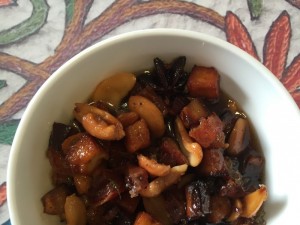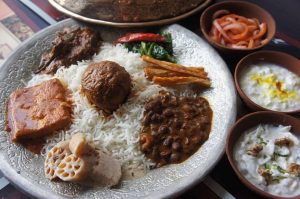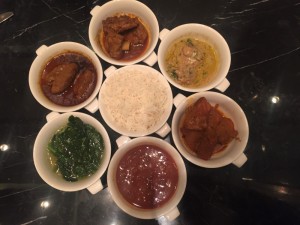If you are a member of one of Delhi’s Facebook food groups, you will have seen a question sooner or later in one or all of them: “Where is the best place to find Kashmiri food in Delhi?” The good news is that there are plenty of places, on an axis from Jama Masjid, South Delhi to Gurgaon. But first, a word about the cuisine itself.
 There are two cuisines in the Kashmir Valley: Muslim and Pandit. They are both different from one another. As Chef Nimish Bhatia puts it, “Wazwan food hits you at the back of the mouth, near the throat, and thus stays on your palate longer. Pandit food is more spicy, comparatively and is perceived in the front of the mouth”. One cuisine is not inherently better or worse, but do be aware that they are different. Wazwan itself is the banquet food of the Muslims of Kashmir; when the Pandits have banquets, they typically call cooks from the Kishtwar region of Jammu to create a set of dishes that are radically different from those served at a wazwan. Whereas a wazwan has a preponderance of meat preparations, the Pandit wedding banquet does have paneer and collard greens (haakh) in addition to rajmah. You would never find these at a Muslim banquet: tomato paneer is the lone vegetarian option. The other thing is that some dishes have become extremely popular and for a host to leave them out of his menu will be to invite scorn if not outrage. Chief among them are gushtaba and rista, two pounded mutton meatballs that have an unique texture. It is an enormous challenge to replicate these outside Kashmir, because the sheep has to be freshly slaughtered and the meat has to be pounded before rigor mortis has set in. It is next to impossible to meet these conditions in Gurgaon and Delhi, which means that having these two items on the menu has a disproportionate amount of back-end work. And because these two dishes have to be made by a hereditary waza, as opposed by a housewife with a food processor, many restaurants serving Kashmiri Muslim cuisine are hard-pressed to hire a waza. There is no such compulsion in Pandit cookery. And now to the restaurants and take-away outlets.
There are two cuisines in the Kashmir Valley: Muslim and Pandit. They are both different from one another. As Chef Nimish Bhatia puts it, “Wazwan food hits you at the back of the mouth, near the throat, and thus stays on your palate longer. Pandit food is more spicy, comparatively and is perceived in the front of the mouth”. One cuisine is not inherently better or worse, but do be aware that they are different. Wazwan itself is the banquet food of the Muslims of Kashmir; when the Pandits have banquets, they typically call cooks from the Kishtwar region of Jammu to create a set of dishes that are radically different from those served at a wazwan. Whereas a wazwan has a preponderance of meat preparations, the Pandit wedding banquet does have paneer and collard greens (haakh) in addition to rajmah. You would never find these at a Muslim banquet: tomato paneer is the lone vegetarian option. The other thing is that some dishes have become extremely popular and for a host to leave them out of his menu will be to invite scorn if not outrage. Chief among them are gushtaba and rista, two pounded mutton meatballs that have an unique texture. It is an enormous challenge to replicate these outside Kashmir, because the sheep has to be freshly slaughtered and the meat has to be pounded before rigor mortis has set in. It is next to impossible to meet these conditions in Gurgaon and Delhi, which means that having these two items on the menu has a disproportionate amount of back-end work. And because these two dishes have to be made by a hereditary waza, as opposed by a housewife with a food processor, many restaurants serving Kashmiri Muslim cuisine are hard-pressed to hire a waza. There is no such compulsion in Pandit cookery. And now to the restaurants and take-away outlets.
 The oldest and the most permanent, is Ahad Sons of Masjid Moth, Behind Uday Park, 26253642. The three brothers, themselves wazas from a prominent Srinagar family, have been located in Delhi since the late ’80s, they are the pioneers of canned wazwan and they sell from a small menu of ten or so preparations in individual portions, cater for parties and even supply to restaurants. For individual portions you do have to go to their commissery (no seating) in Masjid Moth to pick up your order; they will deliver to your doorstep for party catering. Two people can eat for as little as Rs 700. Mirchi Qorma and Seekh Kebabs are my favourite picks. Their canned wazwan is available at Masjid Moth and online at Kashmirbox.com. Generally considered to be the most authentic, their client base include most Kashmiris who live around South Delhi.
The oldest and the most permanent, is Ahad Sons of Masjid Moth, Behind Uday Park, 26253642. The three brothers, themselves wazas from a prominent Srinagar family, have been located in Delhi since the late ’80s, they are the pioneers of canned wazwan and they sell from a small menu of ten or so preparations in individual portions, cater for parties and even supply to restaurants. For individual portions you do have to go to their commissery (no seating) in Masjid Moth to pick up your order; they will deliver to your doorstep for party catering. Two people can eat for as little as Rs 700. Mirchi Qorma and Seekh Kebabs are my favourite picks. Their canned wazwan is available at Masjid Moth and online at Kashmirbox.com. Generally considered to be the most authentic, their client base include most Kashmiris who live around South Delhi.
 Rare is the restaurant or catering service that serves the food of both the Muslim and Pandit cuisines. One of the only restaurants that does, is Chor Bizarre 43663600. The years have been less than kind to the food, however, but as a venue for dinner with overseas guests, the quirky memorabilia, film music of yesteryear and the very location, midway between Old and New Delhi, is hard to match. The newer branch is in Bikaner House and lies in the heart of Central Delhi. The surroundings are extremely well appointed and the prices are realistic. Only about a third of the menu is Kashmiri, but few people bother to order anything else and the Pandit roghan josh is excellent.
Rare is the restaurant or catering service that serves the food of both the Muslim and Pandit cuisines. One of the only restaurants that does, is Chor Bizarre 43663600. The years have been less than kind to the food, however, but as a venue for dinner with overseas guests, the quirky memorabilia, film music of yesteryear and the very location, midway between Old and New Delhi, is hard to match. The newer branch is in Bikaner House and lies in the heart of Central Delhi. The surroundings are extremely well appointed and the prices are realistic. Only about a third of the menu is Kashmiri, but few people bother to order anything else and the Pandit roghan josh is excellent.
23 year old Vivek Dhar believes in going against the grain. He can well afford to, because Daawat e Kashmir (9821542005, 0124-4042048) is a subsidiary business for him. His is a take-away serving Mughlai and Kashmiri food, and though his focus is Pandit cuisine (do not miss the crunchy nadru churma and the khetchar (khichri) with meat, called Kashmiri biryani on the menu), he employs a cook from Jammu who does very creditable ristas and gushtabas, so that the lines between the cuisines are intentionally blurred. Because the business caters to the comparatively cosmopolitan crowd of Gurgaon, there’s a marked trend in the ordering pattern. Non-Kashmiris order Mughlai and Kashmiri interchangeably whereas Kashmiris could order dum aloo as well as ristas with equal gusto.
 Trawl the restaurants in this list and you’ll notice how compact most menus are. It’s a function of demand and supply in a city where Kashmiri food is but one regional cuisine among many others. ITC Maurya’s Pavilion has two weekly buffets by housewife turned chef, Suman Kaul in which at least 15 constantly varying preparations are showcased. Kaul is a passionate hobby cook and has an unending repertoire of uncommon dishes like guchchi ver and apple pakoda. Her Wednesday lunch and Friday dinner buffets are highly recommended for being a rare occasion to find home-cooked food in a five star setting, that too, steering clear of cliches.
Trawl the restaurants in this list and you’ll notice how compact most menus are. It’s a function of demand and supply in a city where Kashmiri food is but one regional cuisine among many others. ITC Maurya’s Pavilion has two weekly buffets by housewife turned chef, Suman Kaul in which at least 15 constantly varying preparations are showcased. Kaul is a passionate hobby cook and has an unending repertoire of uncommon dishes like guchchi ver and apple pakoda. Her Wednesday lunch and Friday dinner buffets are highly recommended for being a rare occasion to find home-cooked food in a five star setting, that too, steering clear of cliches.
Sanjay Raina, of Mealability 9811051615 operates out of Gurgaon. His team cook a range of items that are listed on his Facebook page. You have to order (minimum order applies) any time from Monday to Friday and the food will be delivered to you on the weekend. Raina’s speciality is Pandit food with its trademark touch of asafoetida and his Dum Aloo is very good. No order is too large for him, and with enough advance notice, he can even make a delivery on a week-day.
 Gurgaon has turned out to be the headquarters of Kashmiri food. Nalini Moti Sadhu of Matamal 9899488043 in DLF City Court, Sikandrapur, owns a diminutive little eatery which nevertheless manages not to be cramped. She and her helpers cook, serve and man the telephones with a rare display of warmth and friendliness. The dozen or so seats in Matamal (which means maternal grandma’s home) are usually occupied by friends and friends of friends. The menu is modest, not surprisingly, and consists of Pandit dishes cooked with a home-style flair. The soft music is straight from the Kashmir Valley. When the day is done, Mr Sadhu appears from his office down the corridor and the couple eat in their own restaurant, fussing over one another, just like any much-married couple would. Do try their Shufta, a sweet dish that I have only seen here. Two persons can eat for Rs 800-1000.
Gurgaon has turned out to be the headquarters of Kashmiri food. Nalini Moti Sadhu of Matamal 9899488043 in DLF City Court, Sikandrapur, owns a diminutive little eatery which nevertheless manages not to be cramped. She and her helpers cook, serve and man the telephones with a rare display of warmth and friendliness. The dozen or so seats in Matamal (which means maternal grandma’s home) are usually occupied by friends and friends of friends. The menu is modest, not surprisingly, and consists of Pandit dishes cooked with a home-style flair. The soft music is straight from the Kashmir Valley. When the day is done, Mr Sadhu appears from his office down the corridor and the couple eat in their own restaurant, fussing over one another, just like any much-married couple would. Do try their Shufta, a sweet dish that I have only seen here. Two persons can eat for Rs 800-1000.
Less than five kilometers down Gurgaon’s famously pot-holed roads, is Khyen Chyen. It is on the ground floor of Cross Point Mall 8527739955. Another small eatery (15 seater), this one serves wazwan in settings that call to mind a Kashmiri household, complete with copper tableware gleaming against a jali screen, including a tasht naar that a server brings around to wash your hands before and after eating. The minus side is that the food is adequate if woefully inconsistent. There’s a tendency to cater to the local palate which demands mirchi qorma without too much mirchi and rista with extra gravy! Two can eat for within Rs 1000, which includes a mutton starter, a mutton main course, fat rice (thank god for no basmati here) and mineral water. A good option if you are in the area and are  trying out Kashmiri food for the first time. There are wazas in the kitchen. Their other branch is in My Square, the food court in Select Citywalk, Saket.
trying out Kashmiri food for the first time. There are wazas in the kitchen. Their other branch is in My Square, the food court in Select Citywalk, Saket.
In the unlikely setting of IFFCO Chowk Metro Station, lies Kashmiri Kitchen. Owned by a lady from the Kashmir Valley, the place operates like a take-away with minimal seating. However, Mrs Khan is always at hand to monitor the cooking and the semolina kheer is made by her. Whether you try the shami kebabs, the ristas or the mild yakhni, you will have a great meal.
The other Kashmiri restaurant of note is Samavar on the angle between Greater Kailash and Pamposh Enclave. It occupies space in what is essentially a club for the community (Pamposh Enclave was more or less set up for Kashmiri Pandits in the 1970s). This is the only restaurant on this list that serves Indian and Chinese as well, but the Kashmiri food, cooked by a person from Kishtwar,  Mutch, the elongated meat balls of the Pandit community, is the speciality here, followed by Haakh and Dum Aloo. Do not miss the Nadru Churm here. The large barn-like space effortlessly caters to club members, first timers, seekers of Kashmiri food and drinkers of the spirits at unbelievably low prices, so this is the one space in the NCR that has the vibe of a restaurant in Kashmir.
Mutch, the elongated meat balls of the Pandit community, is the speciality here, followed by Haakh and Dum Aloo. Do not miss the Nadru Churm here. The large barn-like space effortlessly caters to club members, first timers, seekers of Kashmiri food and drinkers of the spirits at unbelievably low prices, so this is the one space in the NCR that has the vibe of a restaurant in Kashmir.
Cafe Illuminatii 43504250 in Khan Market and Road Romeo in Defence Colony sell other cuisines in addition to Kashmiri. The former is a cosy cafe that bustles with activity at all hours. Though every cuisine makes its appearance here from Mexican to Italian, Kashmiri is more of a footnote (the owner is from Kashmir). It is one of the few restaurants in the entire city which does not boast of an in-house waza. On the contrary, the kitchen team make tabak maaz and yakhni with a home-style touch. The atmosphere too has faint touches of the Valley in the arch of the chairs and niches. Road Romeo 65999950, up two flights of  stairs, is a restaurant in the day and on Fridays, Saturdays and Sunday nights, a nightclub. The menu, surprisingly, is a serious mix of Lucknow, Hyderabad and Kashmiri and though there is not a lot of Kashmiri, it is surprisingly good, particularly the roghan josh.
stairs, is a restaurant in the day and on Fridays, Saturdays and Sunday nights, a nightclub. The menu, surprisingly, is a serious mix of Lucknow, Hyderabad and Kashmiri and though there is not a lot of Kashmiri, it is surprisingly good, particularly the roghan josh.
Wazwan is undoubtedly a grand feast, on which several hours of preparation has to be lavished. And the last place you expect to find it is by a grimy pavement. However, hundreds of Delhiites have braved the crowds at the Nizamuddin Basti to eat at Gulfam. Restaurant. A wee bit difficult to find because of the stalls that cover its facade, it is the oldest - if not the grandest - of all Delhi’s Kashmiri restaurants. Two can eat for Rs 500 and the seekh kebabs and ristas are spot on authentic. Lastly, there are two restaurants in Urdu Bazar, close to the Jama Masjid. Bilal Elahi’s Kashmiri Zaiqa (9018111806) is the better of the two: for nine months of the year, it is a pit stop for Kashmiris who visit Delhi and stay in the area. Two can eat for Rs 500 (which includes half portions of two mutton dishes and rotis/rice. There are many other less permanent eateries in the area (including one called Shabnam) that simply cannot be recommended.

